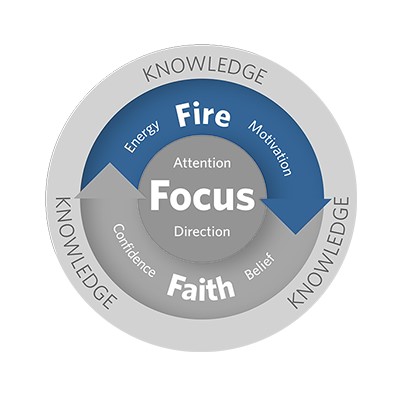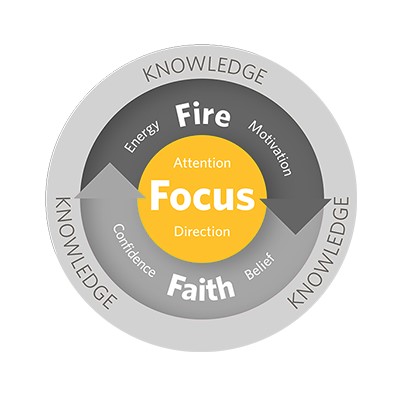In executive coaching and management consultation there is an interesting theory, called the "Pareto Principle" (or the "80/20" rule) which advises that about 20% of an individual's activities will account for around 80% of their results. Here at InsideOut Development, we've seen thousands of individuals succeed by making 20% of their high-impact activities fit into what we call "Faith, Fire, and Focus."
These three elements are so important that when they are blocked in a person, whether in a personal or professional way, that person's performance will suffer. To truly unlock the potential performance of individuals and groups, all three need to be more than present - they need to be prioritized.
So what are each of these elements, and what do we mean by "prioritizing" them when it comes to the corporate world? Let's take a look at each segment and the role it plays in uncovering and maximizing high performance in your organization, group, or business, as well as how these elements appear within high performance organizations.

1. Faith
Faith is the first element, and the foundational one. Faith is not just the belief that someone has in their ability to get or do something - it is also the confidence that others have in their abilities. This capacity to believe in one's possible achievements has become even more apparent in employees with the rise of what the World Economic Forum calls the "belief-driven employee" phenomenon, and is seen in varied industries throughout the globe.
The post-pandemic, belief-driven employee (regardless if they are entry-level or C-suite) wants to have faith not only in themselves that they can achieve key metrics and succeed at the tasks they are responsible for, but they also want to know that their leadership and colleagues believe they can achieve these goals as well.

2. Fire
The second element, Fire, is the excitement someone has about getting or doing something. While it is often easy for leadership to ignore this essential component of high performance, they are doing so at their organization's peril. We understand that humans have an innate tendency for excitement hard-wired into our genetic code, and it's easy to take the corporate stance of, "Of course it isn't exciting, it's work!"
That kind of thinking misses the point of Fire. Fire is the motivation for wanting to not merely do something or mark it off a to-do list - it's also the spark that makes individuals want to accomplish difficult tasks or go above and beyond when it comes to the mundane (yet necessary) activities of work and home. Fire is what lights people up and makes them say, "Not only am I going to accomplish this task - I'm going to do it better than anyone else ever has!"

3. Focus
Focus, the third and final element that must be present to achieve high performance, is the ability of someone to concentrate on the high-impact actions they can take that will end with the result of a job well done. This takes us back to the principles of the 80/20 rule that we started with.
It would be unfair to expect ourselves, our colleagues, or our leadership to be able to focus 100% of the time at work, no matter what distractions we remove from our workspaces. Considering that the average adult attention span is about 20 minutes while at work (which is roughly 33% of each hour), management and leadership can maximize employee performance by concentrating on and incentivizing those high-impact activities that will have a visible effect on company goals.
Prioritizing Faith, Fire, and Focus for High Performance
Now that we have the basic understanding of the "heart elements" that are required for meeting a high performance bar, we need to break down what these look like in practice when they are prioritized.
For employees, management, and executive leadership to prioritize faith within their organizations, the first step is to have a clear, compelling mission and purpose that is communicated clearly and strongly believed in throughout every level of the organization. Organizations without faith are filled with fear, doubt, and lack of clarity concerning the value of the organization's purpose and its ability to grow in today's rapidly changing corporate landscape. Organizations with faith are resilient and able to effectively learn and adapt, making them more likely to continue to be viable regardless of industry changes.
Once an organization or individual has faith in their purpose and mission, we can move on to fire. By activating motivational mechanisms that stimulate performance via proper goal setting, employees and leadership create an inward spiral of performance: the better everyone understands their goals, the more likely they will be to achieve them. This increases the amount of faith both the individual and the organization have, which leads to setting more ambitious goals in the future. Organizations with fire are not only going to set increasingly challenging goals, they are going to reap the rewards of this fire through higher performance and revenues.
Last (but arguably most important) is the element of focus. People and organizations perform better when the priority is focusing on the outcomes of actions rather than the actions themselves. Organizations and individuals that have a lack of focus tend to place emphasis on the individual elements of a task or goal, rather than taking a "big picture" view and concentrating on the intended outcome. Organizations with focus are more successful because every level understands that the intended outcome is the priority - choosing to place emphasis on achieving a goal or completing a task rather than how the goal or task was accomplished.
Conclusion
By incorporating and prioritizing the elements of Faith, Fire, and Focus, expectations regarding objectives, outcomes, and goals will not only be achieved but often exceeded. If you would like to know more about what incorporating Faith, Fire, and Focus would look like for your organization (or yourself!) get in touch with a member of our coaching staff so we can discuss specific solutions for your executive coaching needs.





